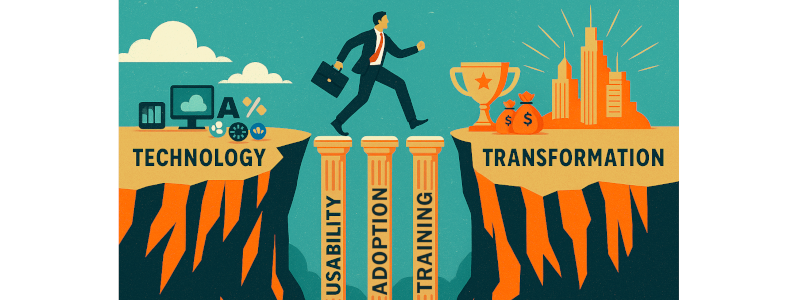When a midsize healthcare group invested over $250,000 in a cutting-edge CRM platform, the leadership team expected a wave of new efficiencies. Six months later, adoption rates hovered at just 30%. Staff had reverted to spreadsheets, email threads, and handwritten notes to manage their workflows — despite the availability of powerful new tools.
Unfortunately, this isn’t an isolated case. According to Bain & Company, only 5% of organizations fully achieve their goals from digital investments, while 71% settle for diluted value or mediocre performance. The core issue isn’t the technology — it’s the behavior.
Businesses often equate purchasing modern systems with achieving transformation. But technology alone is not transformation. True change happens when the people using these systems work differently, think differently, and embrace new ways of operating. Without that human shift, even the most sophisticated solutions become underutilized investments — high-tech cow paths paved over old inefficiencies.
Recognizing and addressing this human dimension is critical for any organization seeking not just to digitize, but to truly transform.
Beyond the Technology: Usability, Adoption, and Training
True digital transformation demands more than new systems — it requires a thoughtful focus on the human experience.
Proactive Technology Management emphasizes three critical human-centered pillars that determine whether a transformation succeeds or stalls:
1. Usability: Design for Human Outcomes, Not Just System Requirements
If a new platform is unintuitive, slow, or forces employees to navigate complex workarounds, frustration quickly sets in. Rather than accelerating work, the technology becomes an obstacle.
Imagine a healthcare practice investing in a new billing system, only to discover it requires ten clicks to complete a task that previously took two. Staff members, under time pressure, quickly create offline spreadsheets to bypass the inefficiency — undermining the investment entirely.
Effective usability starts with human-centered design: understanding user workflows, minimizing friction, and ensuring that new tools feel like a natural extension of how work gets done — not a burden layered on top.
2. Adoption: Building Confidence and Value Perception
Access alone doesn’t guarantee usage. Employees must see clear, tangible benefits to integrating new technology into their daily routines. Without a deliberate adoption strategy, even the best-designed tools may languish in disuse.
For example, rolling out an AI-driven reporting dashboard without tying its insights to real-world decisions — like staffing plans or revenue forecasting — leaves users disconnected. Adoption thrives when users immediately recognize how technology makes their jobs easier, faster, or smarter.
However, even when employees understand a new tool’s potential value, early enthusiasm can fade without reinforcement. Truly successful adoption requires more than awareness — it demands the creation of new daily habits. Bridging the learning curve between understanding and consistent use means guiding employees through that behavioral shift — and that guidance comes through intentional, ongoing training.
3. Training: Empowerment That Evolves With the Technology
Training isn’t a checkbox activity or a one-time workshop. It’s an ongoing process designed to help new behaviors take root and strengthen over time.
An orthopedic group, for instance, may adopt a low-code scheduling app — but if staff are only trained on basic functions, they miss opportunities to automate reminders, collect patient feedback, or optimize no-show rates. Over time, the technology’s potential remains unrealized.
Effective training strategies focus not just on how to use a system, but on embedding its use into daily routines. Reinforcing early wins, celebrating milestones, and providing quick-access support ensures that new workflows become second nature — habits that drive lasting transformation rather than temporary compliance.
Human-Centered Transformation: The Proactive Approach
At Proactive Technology Management, digital transformation is never treated as a purely technical deployment. Every Fusion Development sprint is designed with people at the center — ensuring that usability, adoption, and ongoing habit formation are built into the process from the start.
Rather than overwhelming teams with massive change initiatives, Proactive works in agile, focused iterations that deliver quick wins and visible value early. These smaller, strategic deployments give employees time to adjust, practice new workflows, and build confidence as part of their natural routines. Through continuous feedback loops and real-world usability testing, Proactive ensures that technology becomes an enabler — not an obstacle — for sustainable business evolution.
Signs Your Team Is Struggling with Technology Adoption:

Even the most promising tools can quietly fail if early warning signs are missed. Watch for these common indicators that employees are falling back into old habits — and that additional support or course correction may be needed:
- Manual workarounds reappear: Employees revert to spreadsheets, email chains, or side processes outside the new system.
- Low login or usage rates: Analytics reveal that intended users aren’t consistently engaging with the new platform.
- Shadow processes persist: Old approval chains, manual task tracking, or duplicative data entry continue alongside digital tools.
- Resistance framed as “efficiency”: Teams justify skipping the new system by claiming it’s “faster” to use the old method.
- Training fatigue: Users attend initial training but don’t seek out ongoing learning or refreshers — signaling disengagement rather than mastery.
- Lack of visible quick wins: Employees don’t experience or acknowledge small improvements tied to the new technology.
Recognizing these signs early allows organizations to reframe, retrain, and re-engage before momentum is lost — ensuring that the transformation effort delivers on its full promise.
The PTM Fusion Development Difference
At Proactive Technology Management, technology implementation is never the end goal — true transformation is.
The Fusion Development methodology reflects this belief by integrating human behavior, business process redesign, and technology enablement into a unified, agile framework.
Each Fusion sprint is structured to balance rapid technology deployment with human-centered change management:
- Quick winsare intentionally built into early phases to reinforce adoption and help new behaviors stick.
- User feedback loopsare embedded at every step, ensuring that tools are refined based on real-world usage, not assumptions.
- Training is iterative and empowering, guiding teams beyond basic functionality toward mastering their tools in ways that drive measurable business outcomes.
- Full ownership is transferredto clients — no black-box solutions or hidden dependencies — ensuring that teams can evolve, maintain, and optimize their systems independently over time.
By aligning technology deployment with real human adoption cycles, Proactive helps organizations not just digitize, but fundamentally improve the way they operate — unlocking true, sustainable value.
Ready to Transform Beyond Technology?
Technology can unlock incredible possibilities — but only when it’s paired with a thoughtful, human-centered approach to change.
Organizations that focus on usability, adoption, and ongoing empowerment don’t just digitize their workflows — they reimagine them, building smarter, stronger, and more resilient operations.
If you’re ready to move beyond technology as a tool and toward transformation as a reality, schedule your free discovery consultation today and explore how Fusion Development can align your people, processes, and platforms for sustainable growth.
Follow Michael Weinberger on LinkedIn for ongoing insights into digital transformation, AI innovation, and the future of business operations.

